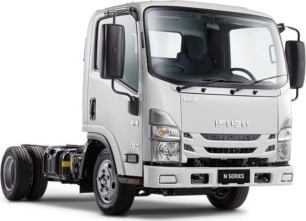There have been no power, torque or driver-assist tech changes to this upgraded Pajero Sport – you’ll have to wait for the next-gen version for those – so no surprises lay in wait when driving.
But that’s okay, because the Pajero Sport in its current guise is a solid daily driver – not spectacular, but far from atrocious.
The Pajero Sport is 4840mm long (with a 2800mm wheelbase), 1815mm wide, 1835mm high and has a kerb weight of 2130kg.
Compared to other similarly-sized 4WD wagons, the Pajero Sport is narrower and has a higher centre of gravity, so it’s nimble – the turning circle is a respectable 11.2m – but it also feels a bit floaty on roads and tracks, but not despicably so.
The Pajero Sport is reasonable on sealed surfaces, although it is sluggish, noisy and there’s quite a lot of body-roll through sharp turns, especially compared to some of its more refined rivals, such as the Ford Everest.
But it is a very capable off-roader, mostly because the driver has access to a raft of technical advantages engineered into the Pajero Sport aimed at making 4WDing a safer challenge.
One of the major points of difference it has with its rivals is Super Select II 4WD. You can switch, via a dial to the rear of the auto shifter, from 2H into 4H (four-wheel drive, high-range), if you're not already driving with 4H engaged, and that gives you the best traction possible in low-grip conditions, which you may face on rough back-roads and dirt tracks peppered with loose rocks and potholes.
There's no risk of transmission wind-up because the centre diff is open when 4H is engaged in the Pajero Sport, so Super Select II 4WD adds an extra element of safety and sure-footedness to your driving experience.
Then turn the dial to 4HLc (four-wheel drive, high-range, locked centre diff) and you're ready to take on more difficult terrain but at lower speeds, because the centre diff is no longer open.
If you want to tackle even harder stuff than high-range territory, turn the dial to 4LLc (four-wheel drive, low-range, locked centre diff) and the Pajero Sport has an opportunity to excel in low-speed, low-range four-wheel driving.
Turn the dial to 4HLc and you're ready to take on more difficult terrain but at lower speeds.
So, along with decent high- and low-range gearing and a centre diff-lock – activated when 4HLc (4WD high-range, locked centre diff) or 4LLc (4WD low-range, locked centre diff) is selected – the Pajero Sport has a rear diff lock, which is engaged/disengaged via a button in front of the shifter and this further help you to easily maintain safe forward momentum.
Hill descent control sustains a controlled low speed of 3.0-4.0km/h all the way down steeper, longer hills.
The GSR also has selectable off-road modes, including Gravel, Sand, Mud/Snow (when in high-range 4WD) and Rock (when in low-range 4WD).
Each of these modes adjusts engine output, transmission settings and braking, the aim being the acquisition of superior traction to suit specific conditions and terrains.
The Pajero Sport is riding on Toyo Open Country A32 all-terrains (265/60R18 110H), which are decent tyres, but it would perform even better with more aggressive rubber.
Wheel travel is adequate, ground clearance (218mm) is reasonable, although you still have to mind your driving line through rough terrain and be mindful of this 4WD’s approach (30 degrees), departure (24.2) and ramp-over (23.1) angles. Wading depth is listed as 700mm.
While it’s never been regarded as a tow rig in the same vein as something like the Toyota LandCruiser or the Nissan Patrol, the Pajero Sport offers sensible claimed towing capacities of 750kg (unbraked) and 3100kg (braked).
Payload is listed as 645kg (so about standard for this size 4WD wagon), gross vehicle mass (GVM) is 2775kg and gross combined mass (GCM) is 5565kg.






